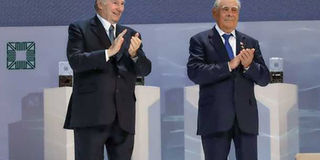First-rate designs feted during Aga Khan architecture awards

His Highness the Aga Khan with Mintimer Shaimiev, State Counsellor of the Republic of Tatarstan. PHOTO | AKDN | AKBAR HAKIM
What you need to know:
- The Aga Khan went on to explain why the Ismaili Imamat was involved with architecture.
- It was also necessary, he added, to foster a dialogue with non-Islamic cultures including diverse religious traditions.
in Kazan, Russia
The six winning projects of the 2019 Aga Khan Award for Architecture (AKAA) were acclaimed on Friday at a ceremony held at Kazan’s Musa Jalil State Academic Opera and Ballet Theatre.
Mintimer Shaimiev, State Counsellor of the Republic of Tatarstan, accompanied His Highness the Aga Khan, hereditary Imam (spiritual leader) of the Ismaili Muslims, in presiding over the Award Ceremony.
Spanning six continents, the six projects share a US$ 1 million cash prize and include an urban heritage intervention, a floating school, a national museum, an ambitious programme to introduce public spaces across hundreds of localities, a university’s classrooms and halls, and an ecological centre.
HUMANITARIAN PROJECTS
“You are implementing the largest charitable, educational and humanitarian projects, support proactive, creative people, regardless of nationality or confession”, said Mintimer Shaimiev in acknowledging the contribution of His Highness.
“Your peacekeeping mission, your commitment to bringing civilisations closer and achieving unity in diversity are consonant with our goals, especially to me, as the UNESCO Special Envoy for Inter-cultural Dialogue.”
Speaking at the ceremony, His Highness the Aga Khan noted that, on this visit to Tatarstan, he had seen “how committed people can honour the power both of cultural identity and cultural pluralism.”
“It is striking to see how churches and mosques, for example, have been built and preserved right next to one another as powerful symbols of a profound inter-cultural dialogue,” he said. These were examples, the Aga Khan explained, of what the world was in particular need of today to meet accelerating needs of environmental, social, technological, economic and political challenges.
The ceremony was attended by Eleonora Valentinovna Mitrofanova, the Ambassador-at-large of the Ministry of Foreign Affairs, other government officials, ambassadors and members of the international diplomatic corps, and leading members of the architectural community from around the world.
CREATIVE DIALOGUES
Speaking about the theme of “Architecture in Dialogue”, which emerged from this 14th cycle of the Award, the Aga Khan explained the potential of the architectural world to inspire and enrich creative dialogues, embracing diverse and even divergent perspectives.
It was also necessary, he added, to foster a dialogue with non-Islamic cultures including diverse religious traditions.
“Architecture can lead the way in this effort as we listen to and learn from one another across old divides,” he said.
The Aga Khan went on to explain why the Ismaili Imamat was involved with architecture.
“The simple answer lies in my conviction that architecture — more than any other art form — has a profound impact on the quality of human life,” he said.




